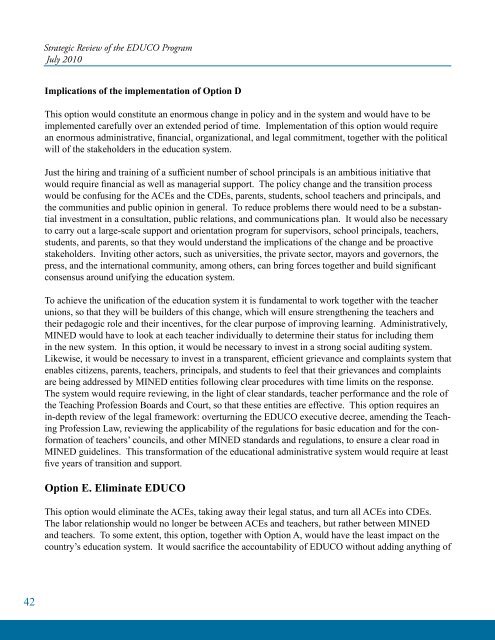Strategic Review of the EDUCO Program - EQUIP123.net
Strategic Review of the EDUCO Program - EQUIP123.net
Strategic Review of the EDUCO Program - EQUIP123.net
You also want an ePaper? Increase the reach of your titles
YUMPU automatically turns print PDFs into web optimized ePapers that Google loves.
<strong>Strategic</strong> <strong>Review</strong> <strong>of</strong> <strong>the</strong> <strong>EDUCO</strong> <strong>Program</strong>July 2010Implications <strong>of</strong> <strong>the</strong> implementation <strong>of</strong> Option DThis option would constitute an enormous change in policy and in <strong>the</strong> system and would have to beimplemented carefully over an extended period <strong>of</strong> time. Implementation <strong>of</strong> this option would requirean enormous administrative, financial, organizational, and legal commitment, toge<strong>the</strong>r with <strong>the</strong> politicalwill <strong>of</strong> <strong>the</strong> stakeholders in <strong>the</strong> education system.Just <strong>the</strong> hiring and training <strong>of</strong> a sufficient number <strong>of</strong> school principals is an ambitious initiative thatwould require financial as well as managerial support. The policy change and <strong>the</strong> transition processwould be confusing for <strong>the</strong> ACEs and <strong>the</strong> CDEs, parents, students, school teachers and principals, and<strong>the</strong> communities and public opinion in general. To reduce problems <strong>the</strong>re would need to be a substantialinvestment in a consultation, public relations, and communications plan. It would also be necessaryto carry out a large-scale support and orientation program for supervisors, school principals, teachers,students, and parents, so that <strong>the</strong>y would understand <strong>the</strong> implications <strong>of</strong> <strong>the</strong> change and be proactivestakeholders. Inviting o<strong>the</strong>r actors, such as universities, <strong>the</strong> private sector, mayors and governors, <strong>the</strong>press, and <strong>the</strong> international community, among o<strong>the</strong>rs, can bring forces toge<strong>the</strong>r and build significantconsensus around unifying <strong>the</strong> education system.To achieve <strong>the</strong> unification <strong>of</strong> <strong>the</strong> education system it is fundamental to work toge<strong>the</strong>r with <strong>the</strong> teacherunions, so that <strong>the</strong>y will be builders <strong>of</strong> this change, which will ensure streng<strong>the</strong>ning <strong>the</strong> teachers and<strong>the</strong>ir pedagogic role and <strong>the</strong>ir incentives, for <strong>the</strong> clear purpose <strong>of</strong> improving learning. Administratively,MINED would have to look at each teacher individually to determine <strong>the</strong>ir status for including <strong>the</strong>min <strong>the</strong> new system. In this option, it would be necessary to invest in a strong social auditing system.Likewise, it would be necessary to invest in a transparent, efficient grievance and complaints system thatenables citizens, parents, teachers, principals, and students to feel that <strong>the</strong>ir grievances and complaintsare being addressed by MINED entities following clear procedures with time limits on <strong>the</strong> response.The system would require reviewing, in <strong>the</strong> light <strong>of</strong> clear standards, teacher performance and <strong>the</strong> role <strong>of</strong><strong>the</strong> Teaching Pr<strong>of</strong>ession Boards and Court, so that <strong>the</strong>se entities are effective. This option requires anin-depth review <strong>of</strong> <strong>the</strong> legal framework: overturning <strong>the</strong> <strong>EDUCO</strong> executive decree, amending <strong>the</strong> TeachingPr<strong>of</strong>ession Law, reviewing <strong>the</strong> applicability <strong>of</strong> <strong>the</strong> regulations for basic education and for <strong>the</strong> conformation<strong>of</strong> teachers’ councils, and o<strong>the</strong>r MINED standards and regulations, to ensure a clear road inMINED guidelines. This transformation <strong>of</strong> <strong>the</strong> educational administrative system would require at leastfive years <strong>of</strong> transition and support.Option E. Eliminate <strong>EDUCO</strong>This option would eliminate <strong>the</strong> ACEs, taking away <strong>the</strong>ir legal status, and turn all ACEs into CDEs.The labor relationship would no longer be between ACEs and teachers, but ra<strong>the</strong>r between MINEDand teachers. To some extent, this option, toge<strong>the</strong>r with Option A, would have <strong>the</strong> least impact on <strong>the</strong>country’s education system. It would sacrifice <strong>the</strong> accountability <strong>of</strong> <strong>EDUCO</strong> without adding anything <strong>of</strong>42

















